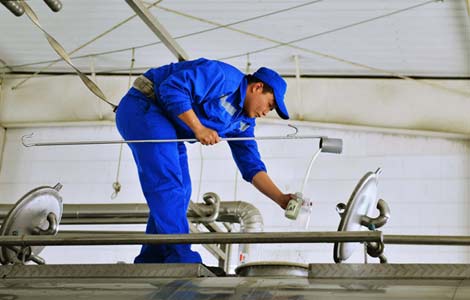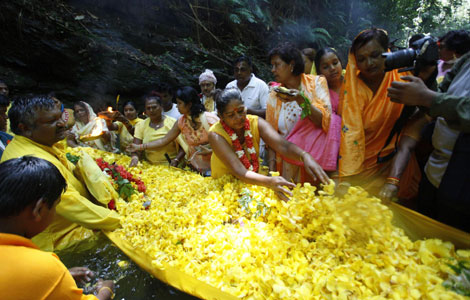Far-out lessons connect Earth
Updated: 2013-06-21 07:03
By Xin Dingding (China Daily)
|
||||||||
|
American teacher Barbara Morgan lifts two astronauts during a video class beamed from the International Space Station in 2007. Xinhua / Reuters |
First lecture in space
The world's first astronaut to deliver a video class from space was Barbara Morgan from the United States, who talked to students on Earth for 25 minutes in 2007.
Morgan, a teacher from Idaho, was initially trained as the backup for Christa McAuliffe - both chosen by Teacher in Space, a NASA program launched in 1984 to inspire students and spur interest in mathematics, science and space exploration.
McAuliffe, a high school teacher from Boston, was selected in 1985 from more than 11,000 applicants as the first teacher in space, and was expected to do experiments and teach two lessons from the space shuttle Challenger. But the ill-fated space shuttle disintegrated soon after launch on Jan 28, 1986.
After McAuliffe's death, NASA ended the Teacher in Space program and barred civilians from space missions. Morgan returned to Idaho to resume her teaching career in 1986.
In the 1990s, NASA launched the Educator Astronaut Program, a successor program to its Teacher in Space project, to help educators and students experience NASA missions.
Morgan was selected by NASA as the first educator astronaut in 1998. As required by the program, she gave up her teaching career and became a mission specialist.
In August 2007, she fulfilled the mission of McAuliffe 22 years ago, riding aboard the space shuttle Endeavor on a construction mission to the International Space Station.
Flanked by two fellow astronauts, she talked to students at the Discovery Center of Boise, Idaho, and answered their questions via a video link.
A student asked how astronauts work out in the space shuttle. Morgan, without explaining directly, held two bulky co-workers by each arm and lifted them up and down.
Another student asked how they drank beer in space. Morgan and her co-workers inserted a straw into a special beverage bag and squeezed the bag. The liquid came out in the form of bubbles, and the astronauts chased them around the space shuttle.
A student also asked: "How does being a teacher relate with being an astronaut on this mission?"
"Astronauts and teachers actually do the same things. We explore, we discover and we share. And the great thing about being a teacher is you get to do that with students. And the great thing about being an astronaut is you get to do it in space. And those are absolutely wonderful jobs," she said.
After the mission ended, Morgan also gave lectures on space education at Walt Disney World.
Education videos
Though only Morgan and Chinese astronaut Wang Yaping have had a chance to interact with students while in orbit, many astronauts have shot videos at the International Space Station and uploaded them online.
Pang Zhihao, deputy editor-in-chief of the monthly publication Space International, said that astronauts at the International Space Station have already recorded videos on at least different 100 topics.
These videos can be viewed for free and have been used in the classroom to explain zero gravity to students, he said.
For instance, Chris Hadfield, who was the first Canadian astronaut and recently retired, recorded a few videos from the International Space Station, and links to the videos have been reposted many times by micro-bloggers in China recently.
In his video, Hadfield discussed astronauts' daily routines in orbit, such as teeth brushing and nail clipping.
In one of his video clips, "Chris Kitchen", Hadfield attached a compressed food bag containing dried spinach to a special water distributor. After Hadfield pushed a button, the dried spinach turned into a juice.
"It is just like magic," Hadfield said.
In another video clip, Hadfield showed how to clip fingernails in orbit. To avoid fingernails from floating everywhere in space, Hadfield trimmed his nails next to an air duct, which sucked them into a garbage bag.
Yu Changxue, a senior official with the Ministry of Education, said on Thursday that the ministry would consider carrying out more experiments with the space program in such aspects.
Chinese students
Chinese students have participated in space programs actively, and some of their ideas have been realized in space.
Media reported that NASA launched a space lab project in 1999, soliciting ideas from students around the world.
Li Taotao, then a fourth-grade student at Beijing Jingshan School, submitted a plan featuring the theme of "silkworms' spinning and cocooning in space". The plan was aimed at observing and documenting the lifespan of silkworms in orbit.
Li's idea was chosen and scheduled by NASA as part of the space shuttle Columbia's bio-tech program. But the experiment did not materialize due to Columbia's explosion in 2003.
The experiment was finally realized onboard China's 22nd recoverable satellite in 2005.
Chinese students' ideas of sending spiders and butterflies into space have also been realized, Pang said.
Jiang Mengyun contributed to this story.
xindingding@chinadaily.com.cn
(China Daily USA 06/21/2013 page3)
Most Viewed
Editor's Picks

|

|

|

|

|

|
Today's Top News
China slams US human trafficking report
China urges resumption of six-party talks
SEC charges China-based firm with fraud
Bank of China denies monetary default report
Snowden's future hangs in balance
China reiterates support for the UN
Dairy measures start at source
June PMI signals weakness
US Weekly

|

|
















